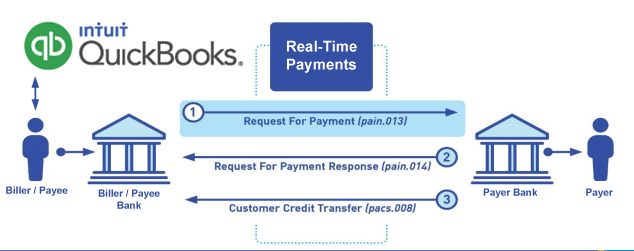QuickBooks® Request for Payment Invoicing
The Best Solution for Payment Processing in QuickBooks®
Today Payments is an Authorized Reseller of Intuit offering a highly robust app that supports both QuickBooks’ desktop and online customers, provide merchants with the tools they need so they can focus more time on their customers and businesses, and less time on data entry. "Our Integrated payment solutions can save a typical small business owner more than 180 hours each year"
"Our Integrated payment solutions can save a typical small business owner more than 180 hours each year"See
the features
QuickBooks® ACH, Cards, FedNow and Real-Time Payments
- Payment processing for all QuickBooks desktop, Pro, Premier, Enterprise and also QBO QuickBooks Online Our software is designed for simplicity and ease-of-use.


- ~ Automate Account Receivable Collection
- ~ Automate Account Payable Payments
- ~ One-time and Recurring Debits / Credits
Secure QB Plugin payment processing through QuickBooks ® specializes in the origination of moving money electronically.
Ask about our special:
Request for Payments
Working with ISO 20022, a standardized
financial messaging format, to handle Request for Payment (RfP) reject
codes in the context of banking halt for receiving funding transmissions
with Banks, Payee, and Payer. The goal is to ensure that the message
data is "cleaned" before syncing into QuickBooks Online (QBO). Here are
some considerations and tips:
ISO 20022 and Banking Halt:
- Reject Code Handling:
- Identify and document the specific
ISO 20022 reject codes relevant to your RfP transactions.
Understand the reasons for rejection to address them
effectively.
- Communication with Banks:
- Establish a communication protocol
with banks to promptly address and resolve rejected payments.
Clear communication is crucial for a smooth resolution process.
- Error Resolution Workflow:
- Develop a clear workflow for
handling rejected payments, including steps to investigate,
correct, and resubmit transactions. This ensures a systematic
approach to resolving issues.
- Documentation:
- Maintain documentation that outlines
the meaning of each reject code and the corresponding resolution
steps. This documentation is valuable for training and reference
purposes.
Syncing with QuickBooks Online (QBO):
- Data Cleaning Process:
- Before syncing with QBO, implement a
data cleaning process to ensure that the information complies
with QBO requirements. This may involve validating data against
QBO fields and formats.
- Validation Rules:
- Establish validation rules to check
for common errors or discrepancies in the data. This can include
checking for duplicate entries, missing information, or
incorrect formatting.
- Pre-Sync Review:
- Conduct a pre-sync review to verify
that all reject codes have been addressed, and the data is in a
clean and accurate state before initiating the sync with QBO.
- Sync Logs:
- Maintain logs of the sync process,
including any errors encountered and the corresponding
resolutions. This helps in identifying patterns and improving
the syncing process over time.
- Audit Trail:
- Implement an audit trail to track
changes made during the data cleaning process. This provides
transparency and accountability in case of any discrepancies.
- User Permissions:
- Define user permissions in QBO to
restrict access to sensitive financial data. Only authorized
personnel should have the ability to initiate syncs or make
changes.
- Training:
- Train relevant personnel on the data
cleaning and syncing process. Ensure they understand the
importance of resolving reject codes before syncing with QBO.
- Regular Updates:
- Stay informed about updates to ISO
20022 standards and QBO requirements. Regularly update your
processes to align with any changes or improvements.
By implementing these considerations, you can
enhance the efficiency and accuracy of handling Request for Payment
reject codes, ensuring that your financial data is cleaned before
syncing into QuickBooks Online. Clear communication, documentation, and
continuous improvement are key elements of a robust financial data
management process.
working with ISO 20022, a standardized
financial messaging format, to handle Request for Payment (RfP) reject
codes in the context of banking halt for receiving funding transmissions
with Banks, Payee, and Payer. The goal is to ensure that the message
data is "cleaned" before syncing into QuickBooks Online (QBO). Here are
some considerations and tips:
ISO 20022 and Banking Halt:
- Reject Code Handling:
- Identify and document the specific
ISO 20022 reject codes relevant to your RfP transactions.
Understand the reasons for rejection to address them
effectively.
- Communication with Banks:
- Establish a communication protocol
with banks to promptly address and resolve rejected payments.
Clear communication is crucial for a smooth resolution process.
- Error Resolution Workflow:
- Develop a clear workflow for
handling rejected payments, including steps to investigate,
correct, and resubmit transactions. This ensures a systematic
approach to resolving issues.
- Documentation:
- Maintain documentation that outlines
the meaning of each reject code and the corresponding resolution
steps. This documentation is valuable for training and reference
purposes.
Syncing with QuickBooks Online (QBO):
- Data Cleaning Process:
- Before syncing with QBO, implement a
data cleaning process to ensure that the information complies
with QBO requirements. This may involve validating data against
QBO fields and formats.
- Validation Rules:
- Establish validation rules to check
for common errors or discrepancies in the data. This can include
checking for duplicate entries, missing information, or
incorrect formatting.
- Pre-Sync Review:
- Conduct a pre-sync review to verify
that all reject codes have been addressed, and the data is in a
clean and accurate state before initiating the sync with QBO.
- Sync Logs:
- Maintain logs of the sync process,
including any errors encountered and the corresponding
resolutions. This helps in identifying patterns and improving
the syncing process over time.
- Audit Trail:
- Implement an audit trail to track
changes made during the data cleaning process. This provides
transparency and accountability in case of any discrepancies.
- User Permissions:
- Define user permissions in QBO to
restrict access to sensitive financial data. Only authorized
personnel should have the ability to initiate syncs or make
changes.
- Training:
- Train relevant personnel on the data
cleaning and syncing process. Ensure they understand the
importance of resolving reject codes before syncing with QBO.
- Regular Updates:
- Stay informed about updates to ISO
20022 standards and QBO requirements. Regularly update your
processes to align with any changes or improvements.
By implementing these considerations, you can
enhance the efficiency and accuracy of handling Request for Payment
reject codes, ensuring that your financial data is cleaned before
syncing into QuickBooks Online. Clear communication, documentation, and
continuous improvement are key elements of a robust financial data
management process.

Call us, the .csv and or .xml Request for Payment (RfP) file you need while on your 1st phone call! We guarantee our reports work to your Bank and Credit Union. We were years ahead of competitors recognizing the benefits of RequestForPayment.com. We are not a Bank. Our function as a role as an "Accounting System" in Open Banking with Real-Time Payments to work with Billers to create the Request for Payment to upload the Biller's Bank online platform. U.S. Companies need help to learn the RfP message delivering their bank. Today Payments' ISO 20022 Payment Initiation (PAIN .013) show how to implement Create Real-Time Payments Request for Payment File up front delivering message from the Creditor (Payee) to it's bank. Most banks (FIs) will deliver the message Import and Batch files for their company depositors for both FedNow and Real-Time Payments (RtP). Once uploaded correctly, the Creditor's (Payee's) bank continuing through a "Payment Hub", will be the RtP Hub will be The Clearing House, with messaging to the Debtor's (Payer's) bank.
Our in-house QuickBooks payments experts are standing ready to help you make an informed decision to move your company's payment processing forward.
Pricing with our Request For Payment Professionals

1) Free ISO 20022 Request for Payment File Formats, for FedNow and Real-Time Payments (The Clearing House) .pdf for you manually create "Mandatory" (Mandatory data for completed file) fields, start at page 4, with "yellow" highlighting. $0.0 + No Support
2) We create .csv or .xml formatting using your Bank or Credit Union. Create Multiple Templates. Payer/Customer Routing Transit and Deposit Account Number may be required to import with your bank. You can upload or "key data" into our software for File Creation of "Mandatory" general file.
Fees = $57 monthly, including Support Fees and Batch Fee, Monthly Fee, User Fee, Additional Payment Method on "Hosted Payment Page" (Request for file with an HTML link per transaction to "Hosted Payment Page" with ancillary payment methods of FedNow, RTP, ACH, Cards and many more!) + $.03 per Transaction + 1% percentage on gross dollar file,
3) Payer Routing Transit and Deposit Account Number is NOT required to import with your bank. We add your URI for each separate Payer transaction.
Fees Above 2) plus $29 monthly additional QuickBooks Online "QBO" formatting, and "Hosted Payment Page" and WYSIWYG
4) Above 3) plus Create "Total" (over 600 Mandatory, Conditional & Optional fields of all ISO 20022 Pain .013) Price on quote.
